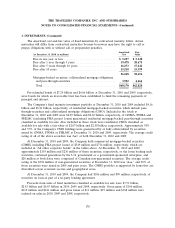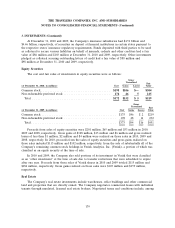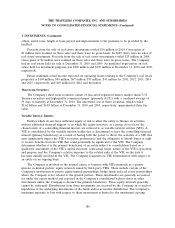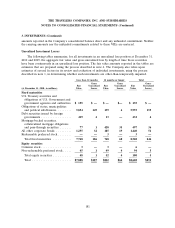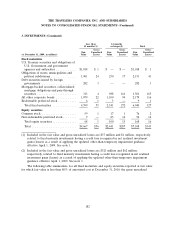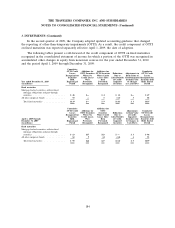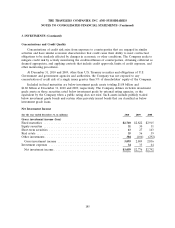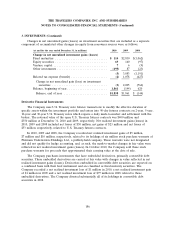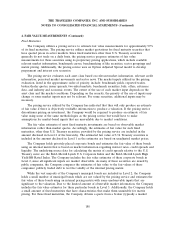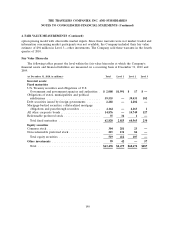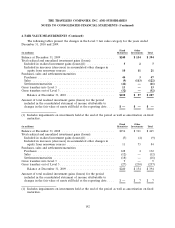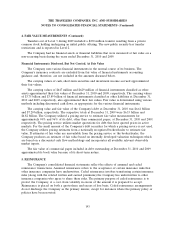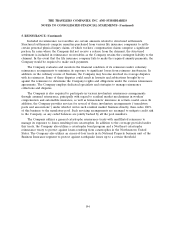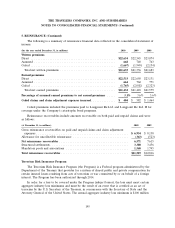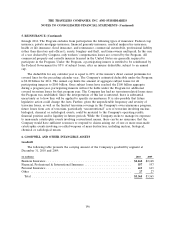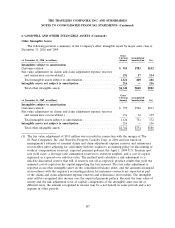Travelers 2010 Annual Report Download - page 200
Download and view the complete annual report
Please find page 200 of the 2010 Travelers annual report below. You can navigate through the pages in the report by either clicking on the pages listed below, or by using the keyword search tool below to find specific information within the annual report.THE TRAVELERS COMPANIES, INC. AND SUBSIDIARIES
NOTES TO CONSOLIDATED FINANCIAL STATEMENTS (Continued)
4. FAIR VALUE MEASUREMENTS (Continued)
Fixed Maturities
The Company utilizes a pricing service to estimate fair value measurements for approximately 99%
of its fixed maturities. The pricing service utilizes market quotations for fixed maturity securities that
have quoted prices in active markets. Since fixed maturities other than U.S. Treasury securities
generally do not trade on a daily basis, the pricing service prepares estimates of fair value
measurements for these securities using its proprietary pricing applications, which include available
relevant market information, benchmark curves, benchmarking of like securities, sector groupings and
matrix pricing. Additionally, the pricing service uses an Option Adjusted Spread model to develop
prepayment and interest rate scenarios.
The pricing service evaluates each asset class based on relevant market information, relevant credit
information, perceived market movements and sector news. The market inputs utilized in the pricing
evaluation, listed in the approximate order of priority, include: benchmark yields, reported trades,
broker/dealer quotes, issuer spreads, two-sided markets, benchmark securities, bids, offers, reference
data, and industry and economic events. The extent of the use of each market input depends on the
asset class and the market conditions. Depending on the security, the priority of the use of inputs may
change or some market inputs may not be relevant. For some securities, additional inputs may be
necessary.
The pricing service utilized by the Company has indicated that they will only produce an estimate
of fair value if there is objectively verifiable information to produce a valuation. If the pricing service
discontinues pricing an investment, the Company would be required to produce an estimate of fair
value using some of the same methodologies as the pricing service but would have to make
assumptions for market-based inputs that are unavailable due to market conditions.
The fair value estimates of most fixed maturity investments are based on observable market
information rather than market quotes. Accordingly, the estimates of fair value for such fixed
maturities, other than U.S. Treasury securities, provided by the pricing service are included in the
amount disclosed in Level 2 of the hierarchy. The estimated fair value of U.S. Treasury securities is
included in the amount disclosed in Level 1 as the estimates are based on unadjusted market prices.
The Company holds privately placed corporate bonds and estimates the fair value of these bonds
using an internal matrix that is based on market information regarding interest rates, credit spreads and
liquidity. The underlying source data for calculating the matrix of credit spreads relative to the U.S.
Treasury curve are the BofA Merrill Lynch U.S. Corporate Index and the BofA Merrill Lynch High
Yield BB Rated Index. The Company includes the fair value estimates of these corporate bonds in
Level 2, since all significant inputs are market observable. As many of these securities are issued by
public companies, the Company compares the estimates of fair value to the fair values of these
companies’ publicly traded debt to test the validity of the internal pricing matrix.
While the vast majority of the Company’s municipal bonds are included in Level 2, the Company
holds a small number of municipal bonds which are not valued by the pricing service and estimates the
fair value of these bonds using an internal pricing matrix with some unobservable inputs that are
significant to the valuation. Due to the limited amount of observable market information, the Company
includes the fair value estimates for these particular bonds in Level 3. Additionally, the Company holds
a small amount of fixed maturities that have characteristics that make them unsuitable for matrix
pricing. For these fixed maturities, the Company obtains a quote from a broker (typically a market
188


